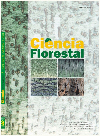
|
Ciência Florestal
Centro de Pesquisas Florestais - CEPEF, Departamento de Ciências Florestais - DCFL, Programa de Pós Graduação em Engenharia Florestal - PPGEF
ISSN: 0103-9954
EISSN: 0103-9954
Vol. 19, No. 2, 2009, pp. 215-224
|
 Bioline Code: cf09021
Bioline Code: cf09021
Full paper language: Portuguese
Document type: Research Article
Document available free of charge
|
|
|
Ciência Florestal, Vol. 19, No. 2, 2009, pp. 215-224
| pt |
O processo AD(EO)D - um novo conceito
Pedrazzi, Cristiane; Muguet, Marcelo Coelho dos Santos; Colodette, Jorge Luiz & Gomide, José Lívio
Resumo
Nesse estudo, investigaram-se cozimentos da madeira até números kappa 17 e 14 por um processo
cineticamente modificado, eliminação da deslignificação com oxigênio da linha de fibras, e aplicação das
técnicas AD(EO)D e AD(PO)D para polpa de kappa 17 e AD(EO)D e DHT(EPO)DP para polpa de kappa 14
para o branqueamento até 90% ISO. Como referências, foram realizados cozimentos até números kappa 17 e
14, deslignificação com oxigênio em simples estágio e branqueamento convencional pelas seqüências
A/D(EO)D, A/D(EPO)D, A/D(EO)DP e A/D(EPO)DP para a polpa de kappa 17 e deslignificação com
oxigênio em simples estágio e branqueamento convencional pela seqüência DHT(EPO)DP para polpa de
kappa 14. Para a polpa de kappa 17, concluiu-se que os processos AD(EO)D e AD(PO)D produzem polpa
de alvura 90% ISO com boa viscosidade e estabilidade de alvura, utilizando TAC´s (Cloro Ativo Total)
relativamente baixos, e dispensam completamente a deslignificação com oxigênio. Dentre esses dois
processos, o primeiro se mostrou mais atrativo para atingir o nível de alvura de 90% ISO. Porém,
comparativamente aos processos de referência, contendo a deslignificação com oxigênio, ex. OA/
D(EPO)DP, o processo AD(EO)D resulta em aumento do custo operacional da ordem de US$7-8/tas,
inclusos madeira e reagentes. Para a polpa de número kappa 14, o processo AD(EO)D também se mostrou
atrativo, sendo que a seqüência DHT(EPO)DP foi a que utilizou o menor TAC`s, porém quando comparada
com a referência (O-DHT(EPO)DP) resultou num aumento de custo operacional da ordem de US$4/tas.
Portanto, pode se concluir que o processo alternativo, sem a deslignificação com oxigênio, é viável somente
para polpas de números kappa mais baixos.
Palavras-chave
cozimento modificado; branqueamento; oxigênio e ácidos hexenurônicos
|
| |
| en |
The AD(EO)D process - a new concept
Pedrazzi, Cristiane; Muguet, Marcelo Coelho dos Santos; Colodette, Jorge Luiz & Gomide, José Lívio
Abstract
In this study, cooking of the wood had been investigated until kappa numbers 17 and 14 for a
process kinetically modified, elimination of oxygen delignification from the fiber line, and application of
AD(EO)D and AD(PO)D techniques for pulp of kappa 17 and AD(EO)D and DHT(EPO)DP for pulp of kappa
14 for the bleaching at 90% ISO. As references, cookings had been carried out until kappa number 17 and
14, oxygen delignification in simple stage and conventional bleaching with sequences A/D(EO)D,
A/D(EPO)D, A/D(EO)DP and A/D(EPO)DP for the kappa number 17 pulp and oxygen delignification in
simple stage and conventional bleaching sequence DHT(EPO)DP for pulp of kappa 14. For the pulp of kappa
17, one concluded that processes AD(EO)D and AD(PO)D produced pulp of brightness 90% ISO with good
viscosity and brightness stability, using TAC´s (totally active chloro) relatively low, and it’s not necessary
the oxygen delignification. Amongst these two processes, the first one revealed to be more attractive to reach
the level of 90% ISO brightness. However, comparatively to the reference processes, with oxygen
delignification, for example O-A/D(EPO)DP, process AD(EO)D results in increase of the operational cost of
the order of US$7-8/odt, including wood and reagents. For the kappa number 14 pulp, process AD(EO)D
also revealed to be attractive, but the sequence DHT(EPO)DP was the one that used lower TAC`s; however,
when compared with the reference (O-DHT(EPO)DP), it resulted in an increase of operational cost of the
order of US$5/odt. Therefore, it can be concluded that the alternative process, without the deslignification with oxygen, is viable only for pulps of lower kappa number.
Keywords
modified cooking; bleaching; delignification degree and Hexenuronic acid
|
| |
© Copyright 2009 - Ciência Florestal
Alternative site location: http://cascavel.ufsm.br/revistas/ojs-2.2.2/index.php/cienciaflorestal/index
|
|
